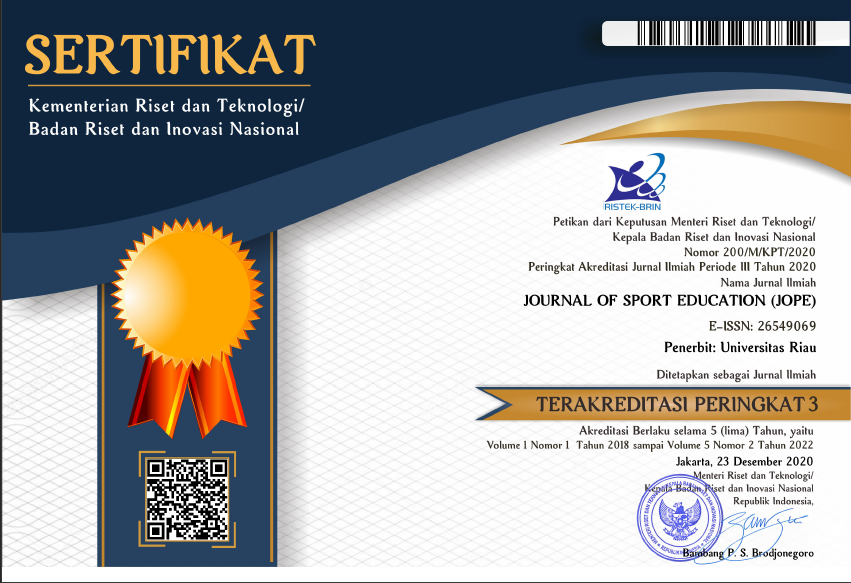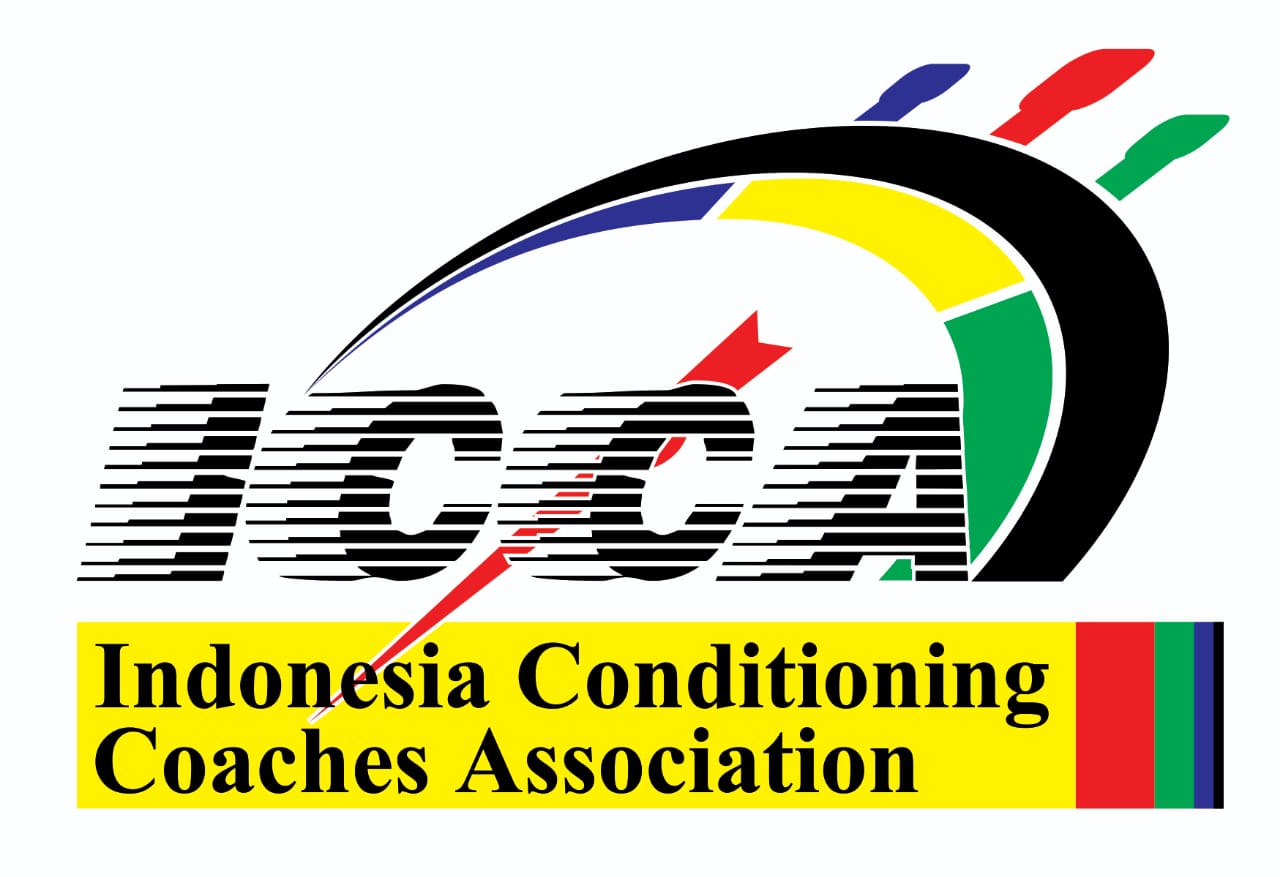Teacher performance and student fitness: is there a significant relationship?
Abstract
(English)
This research aims to reveal the level of PF of students in ten JHS based on the results of PE teachers' performance based on four competencies. Fitness of JHS students in the city of Pekanbaru and the influence of PE teacher performance on fitness student physical. An Ex Post Facto approach was used in this survey research. The instrument to see the performance of PE teachers is to use a questionnaire. Meanwhile, to measure students' PF, the test used is the bleep test. The principal, deputy principal for public relations, deputy principal for curriculum, and one student in class VIII (eight) whose physical fitness data was taken randomly from each school were used as samples in this study. The results of this research include: (1) the performance of JHS PE teachers in Pekanbaru City has met expectations because the four competencies are in the very good category, where personality competency has the highest percentage, (2) Lack of PA inside and outside school will causes low PF of students (Vo2Max), (3) From the results of the regression test which shows a figure of 14.3%, it shows that the high quality of PE teachers' performance does not have a direct impact on students' PF. The conclusion of this research is that the competence of PE teachers does not have a significant impact on students' PF levels because there are other factors that influence it, such as the level of active participation of students inside and outside school. These findings recommend, among other things: (1) the need for consistency in the quality of PE teachers and the professionalism of teachers in schools, (2) the need to maintain the quality of students' PF to improve the quality of life, (3) the need to determine or select PE materials that are adapted to the characteristics of children so that students can be more active in the learning process so that the goals of PE are achieved.
(Indonesian)
Penelitian ini bertujuan untuk mengungkap tingkat kebugaran jasmani siswa di sepuluh sekolah menengah pertama didasarkan pada hasil kinerja guru pendidikan jasmani berdasarkan empat kompetensi. kebugaran siswa sekolah menengah pertama di kota Pekanbaru dan pengaruh kinerja guru pendidikan jasmani terhadap kebugaran. fisik siswa. Pendekatan Ex Post Facto digunakan dalam penelitian survei ini. Instrumen untuk melihat kinerja guru pendidikan jasmani adalah dengan menggunakan angket. Sedangkan untuk mengukur kebugaran jasmani siswa, tes yang digunakan adalah bleep test. Kepala sekolah, wakil kepala sekolah bidang humas, wakil kepala sekolah bidang kurikulum, satu siswa kelas VIII (delapan) yang data kebugaran jasmaninya diambil secara acak disetiap sekolah dijadikan sampel dalam penelitian ini. Hasil penelitian ini antara lain: (1) kinerja guru pendidikan jasmani JHS di Kota Pekanbaru sudah memenuhi harapan karena keempat kompetensi berada pada kategori sangat baik, dimana kompetensi kepribadian mempunyai persentase paling tinggi, (2) Kurangnya aktivitas fisik di dalam dan di luar sekolah akan menyebabkan rendahnya kebugaran jasmani siswa (Vo2Max), (3) Dari hasil uji regresi yang menunjukkan angka 14,3% menunjukkan tingginya kualitas kinerja guru penjas tidak berdampak langsung terhadap kebugaran jasmani siswa. Kesimpulan dari penelitian ini adalah kompetensi guru PE tidak berdampak secara signifikan terhadap tingkat kebugaran jasmani siswa karena ada faktor lain yang mempengaruhinya seperti tingkat partisipasi aktif siswa di dalam maupun luar sekolah. Temuan tersebut merekomendasikan antara lain: (1) diperlukan konsistensi kualitas guru pendidikan jasmani dan profesionalitas guru di sekolah, (2) perlunya menjaga kualitas kebugaran jasmani siswa untuk meningkatkan kualitas hidup, (3) perlunya menetapkan atau memilih materi pendidikan jasmani yang disesuaikan dengan karakteristik anak sehingga siswa dapat lebih aktif dalam proses pembelajaran sehingga tujuan pendidikan jasmani tercapai.
Copyright © The Author (s) 2024

Keywords
References
Anita S. & Damrah. (2020). Kinerja Guru Pendidikan Jasmani Olahraga dan Kesehatan di Masa New Normal Covid-19. Jurnal Kesehatan Medika Saintika, 7(2), 108–113. https://jurnal.syedzasaintika.ac.id/index.php/medika/article/view/859
Bahar, U., & Mutmainna, A. (2021). Pengaruh Kompetensi Dan Kinerja Guru Pendidikan Jasmani Olahraga Dan Kesehatan Terhadap Minat Belajar Permainan Bolavoli Pada Siswa Smp Negeri Di Kota Makassar. JISIP (Jurnal Ilmu Sosial Dan Pendidikan), 5(1), 498–507. https://doi.org/10.58258/jisip.v5i1.1767
Chan, G., Huo, Y., Kelly, S., Leung, J., & Tisdale, C. (2022). The impact of eSports and online video gaming on lifestyle behaviours in youth: A systematic review. Computers in Human Behavior, 126, 106974. https://doi.org/10.1016/j.chb.2021.106974
Damrah, Ptnawati, Rozi, F., Erianti, & Astuti, Y. (2020). Kinerja guru pendidikan jasmani, olahraga dan kesehatan dilihat dari kompetensi pedagogi, kepribadian, sosial dan profesional. Jurnal Ilmu Keolahragaan Undiksha, 8(2), 71–85. https://doi.org/10.23887/JIKU.V8I2.29553
Depdiknas. (2006). Kurikulum Tingkat Satuan Pendidikan (KTSP) untuk Sekolah Dasar/MI.
Erickson, K. I., Hillman, C., Stillman, C. M., Ballard, R. M., Bloodgood, B., Conroy, D. E., …, & Powell, K. E. (2019). Physical Activity, Cognition, and Brain Outcomes: A Review of the 2018 Physical Activity Guidelines. Medicine and Science in Sports and Exercise. 51 (6). 1242-1251. https://doi.org/10.1249/mss.0000000000001936
Fitriani, N. A. (2013). Kompetensi guru pendidikan jasmani olahraga dan kesehatan yang bersertifikat pendidik di smp kota yogyakarta [Universitas Negeri Yogyakarta]. https://eprints.uny.ac.id/16602/1/NURUL.pdf
Habib, A., & Alawi, I. (2019). Kinerja Guru dan Hubungannya Dengan Madrasah Aliyah Asep Habib Idrus Alawi Sekolah Tinggi Agama Islam Shalahuddin Al-Ayyubi Jakarta. Journal of Islamic Education, 1(1), 177–202.
Howie, E. K., & Pate, R. R. (2012). Physical Activity and Academic Achievement in Children: a Historical Perspective. Journal of Sport and Health Science, 1(3), 160–169. https://doi.org/10.1016/j.jshs.2012.09.003
Huda, M. C., & Syam, A. R. (2015). Survei Tingkat Kebugaran Jasmani Siswa SMA Negeri 2 Bojonegoro. Jurnal Pendidikan Olahraga Dan Kesehatan, 3(3), 686–690.
Irmansyah, J., Sakti, N., Syarifoeddin, E., Lubis, M. R., & Mujriah. (2020). Pendidikan jasmani, olahraga, dan kesehatan di sekolah dasar: deskripsi permasalahan, urgensi, dan pemahaman dari perspektif guru. Jurnal Pendidikan Jasmani Indonesia, 16(2), 115–131. http://dx.doi.org/10.21831/jpji.v16i2.31083
Maksum, A. (2012). Metode Penelitian dalam Olahraga. Unesa University Press.
Mashud. (2018). Analisis Masalah Guru PJOK Dalam Mewujudkan Tujuan Kebugaran Jasmani. Jurnal Multilateral, 17(2). 77-85. http://dx.doi.org/10.20527/multilateral.v17i2.5704
Morgan, P. J., & Hansen, V. (2016). Physical Education in Primary Schools: Classroom Teachers’ Perceptions of Benefits and Outcomes. Health Education Journal, 67(3), 196–207. https://doi.org/10.1177/0017896908094637
Mutohir, T. C., Lutan, R., Maksum, A., Kristiyanto, A., & Akbar, R. (2021). Laporan Nasional Sport Development Index Tahun 2021: Olahraga Untuk Investasi Pembangunan Manusia. https://deputi3.kemenpora.go.id/dokumen/30/laporan-nasional-sport-development-index-tahun-2021
Mutohir, T. C., Lutan, R., Maksum, A., Kristiyanto, A., & Akbar, R. (2022). Laporan Nasional Sport Development Index 2022: Olahraga, Daya Saing, dan Kebijakan Berbasis Data. https://deputi3.kemenpora.go.id/dokumen/31/laporan-nasional-sport-development-index-tahun-2022
Opstoel, K., Chapelle, L., Prins, F. J., De Meester, A., Haerens, L., van T., & J., & De Martelaer, K. (2020). Personal and social development in physical education and sports: A review study. European Physical Education Review, 26(4), 797–813. https://doi.org/10.1177/1356336X19882054
Palar, C. M., Wongkar, D,. & Ticoalu, S. H. R. (2015). Manfaat latihan olahraga aerobik terhadap kebugaran fisik manusia. eBiomedik, 3(1). https://ejournal.unsrat.ac.id/index.php/ebiomedik/article/view/7127
Prativi, G. O., Soegiyanto, & Sutardji . (2013). Pengaruh Aktivitas Olahraga Terhadap Kebugaran Jasmani. Journal of Sport Science and Fitness, 2(3), 32–36.
Prianto, D. A., Utomo, M. A. S., Abi Permana, D. A. P., Mutohir, T. C., & Suroto. (2022). Survey Tingkat Kebugaran Jasmani dan Faktor Yang Mempengaruhi Tingkat Kebugaran Jasmani Siswa Sekolah Menengah Pertama di Sidoarjo. Jurnal Segar, 10(2), 49–56. https://doi.org/10.21009/segar/1002.01
Razouki, A., Khzami, S. E., Selmaoui, S., & Agorram, B. (2021). The contribution of physical and sports education to health education of Moroccan middle school students: Representations and practices of teachers. Journal of Education and Health Promotion, 10(1), 201. https://www.ncbi.nlm.nih.gov/pmc/articles/PMC8249976/
Singh, A., Uijtdewilligen, L., Twisk, J. W., V., & Mechelen, W., & Chinapaw, M. J. (2012). Physical activity and performance at school: A systematic review of the literature including a methodological quality assessment. Archives of Pediatrics & Adolescent Medicine, 166(1), 49–55. https://doi.org/10.1001/archpediatrics.2011.716
Sulaiman, J., & Ismail, S. N. (2020). Teacher competence and 21st century skills in transformation schools 2025 (TS25). Universal Journal of Educational Research, 8(8), 3536–3544. https://doi.org/10.13189/ujer.2020.080829
Syam, A. R. (2021). Segala Hal Tentang VO2Max yang Perlu Anda Ketahui.
Syaputra, R. (2020). Kompetensi guru pendidikan jasmani, olahraga dan kesehatan di sekolah dasar negeri sekecamatan luas, kabupaten kaur, provinsi bengkulu. E-SPORT: Jurnal Pendidikan Jasmani, Kesehatan Dan Rekreasi, 1(1), 6–20. https://doi.org/10.31539/e-sport.v1i1.1421
Wanjaya, V. C. G & Hartoto, S. (2019). Hubungan aktivitas fisik dengan tingkat kebugaran jasmani siswa kelas xi sma negeri 1 srengat blitar. Pendidikan Jasmani, 07, 433–437.
Mubarak, W. I., Chayatin, N., Rozikin, K., Supriadi. (2012). Promosi Kesehatan : Sebuah Pengantar Proses Belajar Mengajar dalam Pendidikan. Graha Ilmu.
Wicaksono, P. Y., & Prihanto, J. B. (2017). Peran Guru Pendidikan Jasmani Olahraga Dan Kesehatan Terhadap Pendidikan Kesehatan Di Sma Dan Ma Se-Kecamatan Sooko. Jurnal Pendidikan Olahraga Dan Kesehatan, 5(1), 92–97.
Widodo. (2013). Penerapan tujuh langkah menyusun rencana disiplin kelas proaktif karya colvin dalam pembudayaan hidup aktif dan sehat di sekolah. Jurnal Pendidikan Dan Kebudayaan, 19(3), 331–345. https://doi.org/10.24832/jpnk.v19i3.292
Winarni, S., & Lismadiana, L. (2020). Kompetensi guru pendidikan jasmani olahraga dan kesehatan ditinjau dari usia dan jenis sekolah. Jurnal Pendidikan Jasmani Indonesia, 16(1), 101–114. https://doi.org/10.21831/JPJI.V16I1.29639
Yanova, M. G., Yanov, V. V., Kravchenko, S. V., & Vetrova, I. V. (2021). Professional competences of physical education teachers: Structural and component analysis. Journal of Siberian Federal University - Humanities and Social Sciences, 15(4), 554–558. https://doi.org/10.17516/1997-1370-0477
Yin, et al. (2020). Linking Esports to health risks and benefits: Current knowledge and future research needs. Journal of Sport and Health Science, 9 (6), 485–488. https://doi.org/10.1016/j.jshs.2020.04.006
DOI: http://dx.doi.org/10.31258/jope.6.2.126-138
Refbacks
- There are currently no refbacks.











